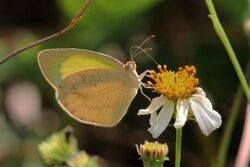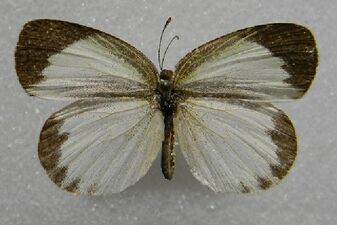Biology:Eurema daira
From HandWiki
Short description: Species of butterfly
| Eurema daira | |
|---|---|

| |
| E. d. palmira, Cuba | |
| Scientific classification | |
| Domain: | Eukaryota |
| Kingdom: | Animalia |
| Phylum: | Arthropoda |
| Class: | Insecta |
| Order: | Lepidoptera |
| Family: | Pieridae |
| Genus: | Eurema |
| Species: | E. daira
|
| Binomial name | |
| Eurema daira (Godart, [1819])[2]
| |
| Synonyms | |
| |
Eurema daira, the fairy yellow, barred yellow or barred sulphur, is a butterfly of the family Pieridae. The species was first described by Jean-Baptiste Godart in 1819. It is found from Argentina north to the southern United States. Strays can be found up to southern Arizona, South Dakota, southern Texas and even Washington, D.C.
The wingspan is 32–41 mm. Adults are on wing year round in the southern part of the range and in late summer and fall as vagrant.
The larvae feed on Fabaceae species, including Stylosanthes biflora and Aeschynomene species. Adults feed on the nectar of various flowers including joint vetches and shepherd's needle, and are the principal pollinators of Cnidoscolus urens.
Subspecies
- E. d. daira (Virginia, New York, Virginia, Louisiana, Georgia, Florida)
- E. d. palmira (Poey, [1852]) (West Indies, Cuba, Bahamas)
- E. d. eugenia (Wallengren, 1860) (Mexico, Panama, Costa Rica, Guatemala)
- E. d. sidonia (R. Felder, 1869) (Mexico)
- E. d. lydia (C. Felder & R. Felder, 1861) (Venezuela, Colombia)
- E. d. macheti Brévignon, 1996 (French Guiana)
References
- ↑ "NatureServe Explorer 2.0 Eurema daira Barred Yellow". https://explorer.natureserve.org/Taxon/ELEMENT_GLOBAL.2.118244/Eurema_daira. Retrieved 3 October 2020.
- ↑ Savela, Markku (February 24, 2019). "Eurema daira (Godart, 1819)". https://www.nic.funet.fi/pub/sci/bio/life/insecta/lepidoptera/ditrysia/papilionoidea/pieridae/coliadinae/eurema/#daira. Retrieved January 8, 2020.
External links
- Lotts, Kelly; Naberhaus, Thomas (2017). "Barred Yellow Eurema daira (Godart, 1819)". https://www.butterfliesandmoths.org/species/Eurema-daira. Retrieved January 8, 2020.
Wikidata ☰ Q1219381 entry
 |






